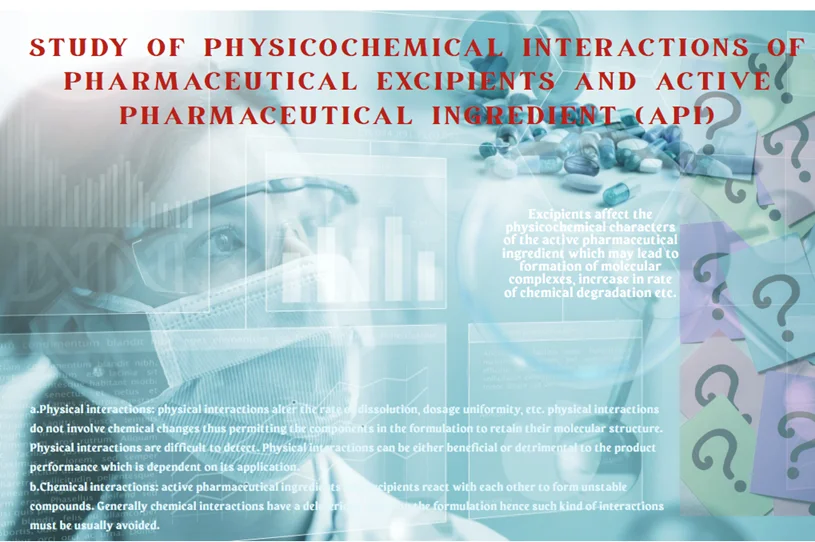PHYSICOCHEMICAL INTERACTIONS OF PHARMACEUTICAL EXCIPIENTS
INTRODUCTION
Physicochemical interactions of pharmaceutical excipients and active pharmaceutical ingredient lead to formation of molecular complexes, increase in rate of chemical degradation etc.
STUDY OF PHYSICOCHEMICAL INTERACTIONS OF PHARMACEUTICAL EXCIPIENTS AND ACTIVE PHARMACEUTICAL INGREDIENT (API)
Excipients even though considered inert substance, have the tendency to react with drug components, other excipients, and also the packaging system.
Excipients affect the physicochemical characters of the active pharmaceutical ingredient which may lead to formation of molecular complexes, increase in rate of chemical degradation etc. Physicochemical interactions of pharmaceutical excipients are further classified as
- Physical interactions
- Chemical interactions

Types of interactions
- Physical interactions: physical interactions alter the rate of dissolution, dosage uniformity, etc. physical interactions do not involve chemical changes thus permitting the components in the formulation to retain their molecular structure. Physical interactions are difficult to detect. Physical interactions can be either beneficial or detrimental to the product performance which is dependent on its application.
- Chemical interactions: active pharmaceutical ingredients and excipients react with each other to form unstable compounds. Generally chemical interactions have a deleterious effect on the formulation hence such kind of interactions must be usually avoided.
| PHYSICAL INTERACTIONS | ||
| Interaction | Beneficial effect examples | Detrimental effect examples |
| Complexation: Usually binds reversibly with drugs to form complex, sometimes insoluble complexes are formed which lead to slower dissolution and decreased absorption of drug. Result observed in such cases is detrimental Complexing agents can also be used to increase bioavailability of poorly water-soluble drugs Result observed in such case is beneficial | Cyclodextrin is often used to improve bioavailability of poorly water-soluble drugs. This increases bioavailability and increases rate and extent of drug dissolution by increasing mucosal permeability or increasing stability of drug.) Complexation of Cyclodextrin with ursodeoxycholic acid increased bioavailability caused by increased dissolution. | Tetracycline formed insoluble complex with calcium carbonate leading to slower dissolution and decreased absorption) Formulation of chlorpromazine with polysorbate 80 and sodium lauryl sulphate decreased membrane permeability of drug. |
| Adsorption: Adsorption of drug by excipient can lead to reduced bioavailability as the drug is not available for dissolution. Adsorption of drug on excipient surface can assist in increasing surface area of drug available for dissolution which eventually increases bioavailability. | Formulation of Indomethacin (NSAID) using kaolin as adsorbent increased its dissolution rate which leads to increase in bioavailability of drug. | 1) Cetyl Pyridinium chloride cations get adsorbed on the surface of magnesium stearate which acts as a lubricant in tablet containing Cetyl Pyridini8um chloride. This leads to marked reduction in the antibacterial activity of the drug. 2) Decrease in absorption of dicumarol in the formulations containing excipients like Aluminum hydroxide, Starch, Talc, owing to the adsorbing properties of excipients |
| Solid dispersion: This kind of interactions improves the dissolution and bioavailability of hydrophobic drugs. Sometimes solid dispersion interactions can result in slow dissolution of drugs. | Improved dissolution rates of drugs like Piroxicam, Norfloxacin, Nifedipine and Ibuprofen were observed when these drugs were formulated into solid dispersions using Polyethylene glycol of different molecular weights. | Solid dispersion product formed due to interaction between Povidone and Stearic acid in a capsule showed slow dissolution of drugs. |
| CHEMICAL INTERACTIONS | ||
| Interaction | Defect Observed | Examples of drugs undergoing such interactions |
| Hydrolysis | Drugs with functional groups like esters, amides, lactones, undergo hydrolysis, in presence of water, low or high pH, in presence of alkaline metals, acids, acids i.e. anion and hydrogen ion, alkali etc. | Anaesthetics , antibiotics, vitamins, and barbiturates, |
| Oxidation | Oxidative reactions are catalyzed by oxygen, light, heavy metal ions, fumed metal oxides, fumed silica, fumed, zirconia etc. Oxidation process involves removal of an electropositive atom or electron or radical, or addition of oxygen atom, generally the interactions of the active pharmaceutical ingredients are with oxidizing impurities in excipients or oxidative degradation products of excipients Drugs with substructures like Benzilic carbons, Allylic carbons, Tertiary carbons, and α position of heteroatoms undergo oxidation. | Steroids, Vitamins, Antibiotics, Epinephrine, Aldehydes, Alcohols, Phenols. |
| Racemization | Conversion of a chemical into its optical or geometric isomer, having different pharmacological or toxicological activity.(here optically active substance looses its optical activity without change in chemical composition) .biological activity of the formulations is hampered as for e.g. biological effect of a drug in dextro form can be less than that in levo form. | Adrenaline has optical 15-20 times greater biological activity then D –Adrenaline. |
| Polymerization | polymorphic forms possess higher potential energy with respect to the thermodynamically stable or lowest energy forms. This potential energy is given out during mixing with the solvent, in some cases potential energy of compound is sufficient to exhibit an apparent solubility greater than more stable form which may eventually result into reversion of drug into less soluble form | Amorphous forms of sodium and potassium Penicillin-G were unstable to dry heat, whereas crystalline forms were stable for several hours. |
| Maillard reactions | Carbonyl group of sugar reacts with amino acid, producing N- substituted Glycosylamine and water, unstable Glycosylamine undergoes amidroid rearrangement forming ketosamine which reacts to produce water and reductones or produce short chain hydrolytic fission products etc, rate of Maillard reactions increases as the water activity increases. | Primary amines undergo maillard reactions, causes yellow brown coloration of drugs like chlorpromazine, etc. Maillard reaction products found in capsule containing lactose and antidepressant Fluoxetine. |
| Photolysis | Decomposition resulting from absorption of radiant energy in the form of light. Reactions like ring alterations, oxidation reduction, polymerization etc are catalyzed or accelerated by exposure to sunlight. Exposure to light may lead to discoloration or even decomposition of product | Such interactions are observed in Riboflavin, Folic acids, Nifedipine, containing formulations. Prednisolone and Methylprednisolone degradation is observed in alcoholic preparations. |

